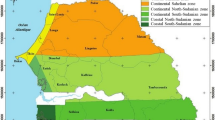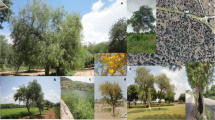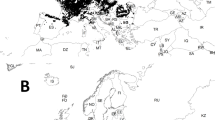Abstract
The aim of this study was to have a comparative investigation and evaluation of the capabilities of correlative and mechanistic modeling processes, applied to the projection of future distributions of date palm in novel environments and to establish a method of minimizing uncertainty in the projections of differing techniques. The location of this study on a global scale is in Middle Eastern Countries. We compared the mechanistic model CLIMEX (CL) with the correlative models MaxEnt (MX), Boosted Regression Trees (BRT), and Random Forests (RF) to project current and future distributions of date palm (Phoenix dactylifera L.). The Global Climate Model (GCM), the CSIRO-Mk3.0 (CS) using the A2 emissions scenario, was selected for making projections. Both indigenous and alien distribution data of the species were utilized in the modeling process. The common areas predicted by MX, BRT, RF, and CL from the CS GCM were extracted and compared to ascertain projection uncertainty levels of each individual technique. The common areas identified by all four modeling techniques were used to produce a map indicating suitable and unsuitable areas for date palm cultivation for Middle Eastern countries, for the present and the year 2100. The four different modeling approaches predict fairly different distributions. Projections from CL were more conservative than from MX. The BRT and RF were the most conservative methods in terms of projections for the current time. The combination of the final CL and MX projections for the present and 2100 provide higher certainty concerning those areas that will become highly suitable for future date palm cultivation. According to the four models, cold, hot, and wet stress, with differences on a regional basis, appears to be the major restrictions on future date palm distribution. The results demonstrate variances in the projections, resulting from different techniques. The assessment and interpretation of model projections requires reservations, especially in correlative models such as MX, BRT, and RF. Intersections between different techniques may decrease uncertainty in future distribution projections. However, readers should not miss the fact that the uncertainties are mostly because the future GHG emission scenarios are unknowable with sufficient precision. Suggestions towards methodology and processing for improving projections are included.








Similar content being viewed by others
References
Abbas I, Mouhi M, Al-Roubaie J, Hama N, El-Bahadli A (1991) Phomopsis phoenicola and Fusarium equiseti, new pathogens on date palm in Iraq Mycol Res 95:509
Al-Khayri JM, Jain SM, Johnson DV (2014) Date palm genetic resources and utilization, Springer Dordrecht Heidelberg, New York London
Al-Senaidy M, Abdurrahman M, Mohammad A (2011) Purification and characterization of membrane-bound peroxidase from date palm leaves (Phoenix dactylifera L). Saudi J Biol Sci 18:293–298. doi:10.1016/j.sjbs.2011.04.005
Al-Shahib W, Marshall RJ (2003) The fruit of the date palm: its possible use as the best food for the future? Int J Food Sci Nutr 54:247–259
Anderson R et al. (2006) Novel methods improve prediction of species’ distributions from occurrence data. Ecography 29:129–151
Auda H, Khalaf Z (1979) Studies on sprout inhibition of potatoes and onions and shelf-life extension of dates in Iraq. J Radiat Phys Chem 14:775–781. doi:10.1016/0146-5724(79)90113-4
Beaumont LJ, Hughes L, Pitman AJ (2008) Why is the choice of future climate scenarios for species distribution modelling important? Ecol Lett 11:1135–1146 doi:10.1111/j.1461-0248.2008.01231.x
Bokhary H (2010) Seed-borne fungi of date-palm, Phoenix dactylifera L from Saudi Arabia Saudi. J Biol Sci 17:327–329 doi:10.1016/j.sjbs.2010.06.005
Bolker B (2012) R Development Core Team, 2014. bbmle: Tools for general maximum likelihood estimation R package version 1
Botes A, Zaid A (2002) The economic importance of date production and international trade. In: Zaid A, Arias-Jimenez EJ (eds) Date palm cultivation. FAO plant production and protection paper, 156 rev. 1. FAO, Rome
Breiman L (2001) Random forests Mach Learn 45:5–32
Burt J (2005) Growing date palms in Western Australia. Available at: http://www.agric.wa.gov.au/objtwr/imported_assets/content/hort/fn/cp/strawberries/f05599.pdf.
CAB Direct (2015) http://www.cabdirect.org/web/about.html, Accessed January 2015. Accessed Jan 2015
Carroll C (2010) Role of climatic niche models in focal-species-based conservation planning: assessing potential effects of climate change on Northern Spotted Owl in the Pacific Northwest. USA Biol Conserv 143:1432–1437
Chao C, Krueger R (2007) The date palm (Phoenix dactylifera L.): overview of biology, uses, and cultivation. J Hortscience 42:1077–1083
Dormann CF (2007) Promising the future? Global change projections of species distributions. Basic Appl Ecol 8:387–397
EarthExplorer (2014) http://earthexplorer.usgs.gov/. Accessed 10 Feb 2012
Elhoumaizi M, Saaidi M, Oihabi A, Cilas C (2001) Phenotypic diversity of date-palm cultivars (Phoenix dactylifera L.) from Morocco Genet Resour Crop Evol 49:483–490
Elith J, Leathwick JR (2009) Species distribution models: ecological explanation and prediction across space and time. Ann Rev Ecol, Evol, Syst 40:677–697
Elith J, Leathwick JR, Hastie T (2008) A working guide to boosted regression trees. J Anim Ecol 77:802–813
Elshibli S, Elshibli E, Korpelainen H (2009) Date Palm (Phoenix dactylifera L.) Plants under water stress: maximisation of photosynthetic CO2 supply function and ecotypespecific response. “Biophysical and Socio-economic Frame Conditions for the Sustainable Management of Natural Resources” Tropentag, Hamburg. Available at http://www.tropentag.de/2009/abstracts/links/Elshibli_FGClTsVL.pdf
Eshraghi P, Zarghami R, Mirabdulbaghi M (2005) Somatic embryogenesis in two Iranian date palm Afr J Biotechnol 4:1309–1312
Global Biodiversity Information Facility (2015) available at: http://www.gbif.org/, Jan 2015.
Grendar M Jr, Grendár M (2000) What is the question that MaxEnt answers? A probabilistic interpretation arXiv preprint math-ph/0009020
Hasan S, Baksh K, Ahmad Z, Maqbool A, Ahmed W (2006) Economics of growing date palm in Punjab, Pakistan. Int J Agric Biol 8:1–5
Heakal MS, Al-Awajy MH (1989) Long-term effects of irrigation and date-palm production on Torripsamments. Saudi Arab Geoderma 44:261–273. doi:10.1016/0016-7061(89)90035-9
Hirzel AH, Le lay G (2008) Habitat suitability modelling and niche theory. J Appl Ecol 45:1372–1381
IPCC IPoCC (2007) Climate change 2007: synthesis report. Summary for Policymakers, IPCC, Geneva
Jackson CR, Robertson MP (2011) Predicting the potential distribution of an endangered cryptic subterranean mammal from few occurrence records. J Nat Conserv 19:87–94
Jain S (2011) Prospects of in vitro conservation of date palm genetic diversity for sustainable production. Emirates J Food Agric 23:110–119
Jain S, Al-Khayri J, Dennis V, Jameel M (2011) Date palm biotechnology. 1st edn. Springer, Berlin
Jeschke JM, Strayer DL (2008) Usefulness of bioclimatic models for studying climate change and invasive species. Ann New York Acad Sci 1134:1–24
Kadmon R, Farber O, Danin A (2003) A systematic analysis of factors affecting the performance of climatic envelope models. Ecol Appl 13:853–867
Kassem H (2012) The response of date palm to calcareous soil fertilisation. J Soil Sci Plant Nutr 12:45–58
Kearney M, Porter W (2009) Mechanistic niche modelling: combining physiological and spatial data to predict species’ ranges. Ecology Lett 12:334–350
Khayyat M, Tafazoli E, Eshghi S, Rajaee S (2007) Effect of nitrogen, boron, potassium and zinc sprays on yield and fruit quality of date palm Am Eurasian J Agric. Environ Sci 2:289–296
Kriticos DJ, Randall RP (2001) Weed risk assessment. In: Groves RH, Panetta FD, Virtue JG (eds) A comparison of systems to analyze potential weed distributions. CSIRO Publishing, Collingwood, pp. 61–79
Kriticos D, Potter K, Alexander N, Gibb A, Suckling D (2007) Using a pheromone lure survey to establish the native and potential distribution of an invasive Lepidopteran. J Appl Ecol 44:853–863
Kriticos D, Webber B, Leriche A, Ota N, Macadam I, Bathols J, Scott J (2011) Global high-resolution historical and future scenario climate surfaces for bioclimatic modelling. Methods Ecol Evol 3:53–64. doi:10.1111/j.2041-210X.2011.00134.x
Kriticos DJ, Webber BL, Leriche A, Ota N, Macadam I, Bathols J, Scott JK (2012) CliMond: global high-resolution historical and future scenario climate surfaces for bioclimatic modelling. Methods Ecol Evol 3:53–64
Kumar S, Stohlgren TJ (2009) Maxent modeling for predicting suitable habitat for threatened and endangered tree Canacomyrica monticola in New Caledonia. J Ecol Nat Environ 1:094–098
Liaw A, Wiener M (2002) Classification and regression by randomForest. R news 2:18–22
Loiselle BA, Howell CA, Graham CH, Goerck JM, Brooks T, Smith KG, Williams PH (2003) Avoiding pitfalls of using species distribution models in conservation planning. Conserv Biol 17:1591–1600
Mahmoudi H, Hosseininia G (2008) Enhancing date palm processing, marketing and pest control through organic culture. J Org Syst 3:30–39
Markhand G (2010) Fruit characterization of Pakistani dates. Available at: http://www.pakbs.org/pjbot/PDFs/42%286%29/PJB42%286%293715.pdf, Accessed 9 January 2012 Pakistan Journal of Botany 42:3715–3721
Marqués J, Duran-Vila N, Daròs J-A (2011) The Mn-binding proteins of the photosystem II oxygen-evolving complex are decreased in date palms affected by brittle leaf disease. Plant Phys Biochem 49:388–394. doi:10.1016/j.plaphy.2011.02.008
Missouri Botanical Garden (2015) Available at: http://www.missouribotanicalgarden.org/, Accessed Jan 2015. http://www.missouribotanicalgarden.org/. 20 Feb 2012
Nazeri M, Jusoff K, Madani N, Mahmud AR, Bahman AR, Kumar L (2012) Predictive modeling and mapping of Malayan Sun bear (Helarctos malayanus) distribution using maximum entropy PLoS One 7:e48104
Pearce J, Ferrier S (2000) Evaluating the predictive performance of habitat models developed using logistic regression. Ecol Model 133:225–245
Pearson RG et al. (2006) Model-based uncertainty in species range prediction. J Biogeogr 33:1704–1711
Peterson AT (2003) Predicting the geography of species’ invasions via ecological niche modelling Q Rev Biol 78:419–433
Phillips S (2005) A brief tutorial on Maxent AT&T Research, Bedminster
Phillips SJ, Dudík M (2008) Modeling of species distributions with Maxent: new extensions and a comprehensive evaluation. Ecography 31:161–175
Phillips SJ, Anderson RP, Schapire RE (2006) Maximum entropy modeling of species geographic distributions. Ecol Model 190:231–259
Reilly D, Reilly, R Gurra downs, date palms, Available at: http://www.gurradowns.com.au/Ourplantation.php, Accessed 19 2013. Accessed 07/03
Ridgeway G (2006) Generalized boosted regression models Documentation on the R Package ‘gbm’, version 1·5 7
Rodda GH, Jarnevich CS, Reed RN (2011) Challenges in identifying sites climatically matched to the native ranges of animal invaders. PLoS One 6:e14670
Shabani F, Kotey BA (2016) Future distribution of cotton and wheat in Australia under potential climate change. J Agric Sci 154(2):175–185
Shabani F, Kumar L (2013) Risk levels of invasive Fusarium oxysporum f. sp. in areas suitable for date palm (Phoenix dactylifera) cultivation under various climate change projections. PLoS One 8:e83404. doi:10.1371/journal.pone.0083404
Shabani F, Kumar L (2014) Sensitivity analysis of CLIMEX parameters in modeling potential distribution of Phoenix dactylifera L. PLoS One 9:e94867. doi:10.1371/journal.pone.0094867
Shabani F, Kumar L (2015) Should species distribution models use only native or exotic records of existence or both?. Ecological Informatics 29: 57–65
Shabani F, Kumar L, Taylor S (2012) Climate change impacts on the future distribution of date palms: a modeling exercise using CLIMEX PLoS One 7:e48021 doi:10.1371/journal.pone.0048021
Shabani F, Kumar L, Esmaeili A (2013a) Use of CLIMEX, Land use and topography to refine areas suitable for date palm cultivation in Spain under climate change scenarios J Earth Sci Clim Chang 4 doi:10.4172/2157-7617.1000145
Shabani F, Kumar L, Esmaeili A, Saremi H (2013b) Climate change will lead to larger areas of Spain being conducive to date palm cultivation J Food. Agric Environ 11:2441–2446
Shabani F, Kumar L, Taylor S (2013c) Suitable regions for date palm cultivation in Iran are predicted to increase substantially under future climate change scenarios. J Agric Sci 152:543–557. doi:10.1017/S0021859613000816
Shabani F, Kumar L, Taylor S (2014a) Distribution of date palms in the middle east based on future climate scenarios Cambridge. J Exp Agric 51:244–263. doi:10.1017/S001447971400026X
Shabani F, Kumar L, Taylor S (2014b) Projecting date palm distribution in Iran under climate change using topography, physicochemical soil properties, soil taxonomy, land use and climate data. Theor Appl Climatol 152:543–557 doi:10.1007/s00704-013-1064-0
Shabani F, Kumar L, Esmaeili A (2015) A modelling implementation of climate change on biodegradation of Low-Density Polyethylene (LDPE) by Aspergillus niger in soil. Global Ecology and Conservation 4:388–398
Shabani F, Kumar L, Nojoumian AH, Esmaeili A, Toghyani M (2016) Projected future distribution of date palm and its potential use in alleviating micronutrient deficiency. J Sci Food Agric 96(4):1132–1140
Shayesteh N, Marouf A (2010) Some biological characteristics of the Batrachedra amydraula Meyrick (Lepidoptera: Batrachedridae) on main varieties of dry and semi-dry date palm of Iran. 10th International Working Conference on Stored Product Protection. In: 10th International Working Conference on Stored Product Protection, Portugal, Estoril Congress Center, .
Soberón JM (2010) Niche and area of distribution modeling: a population ecology perspective. Ecography 33:159–167
Sutherst RW, Bourne AS (2009) Modelling non-equilibrium distributions of invasive species: a tale of two modelling paradigms. Biol Invasions 11:1231–1237. doi:10.1007/s10530-008-9335-x
Sutherst RW, Maywald G (1985) A computerized system for matching climates in ecology. Agriculture Ecosystems Environ 13:281–299
Sutherst RW, Maywald G, Kriticos DJ (2007a) CLIMEX version 3: User’s guide. Melbourne, Hearne Scientific Software
Sutherst RW, Maywald GF, Bourne AS (2007b) Including species interactions in risk assessments for global change. Global Chang Biol 13:1843–1859. doi:10.1111/j.1365-2486.2007.01396.x
Svetnik V, Liaw A, Tong C, Culberson JC, Sheridan RP, Feuston BP (2003) Random forest: a classification and regression tool for compound classification and QSAR modeling Journal of chemical information and computer sciences 43:1947–1958
Tengberg M (2011) Beginnings and early history of date palm garden cultivation in the Middle East J Arid Environ 5:1–9
Townsend Peterson A, Papeş M, Eaton M (2007) Transferability and model evaluation in ecological niche modeling: a comparison of GARP and Maxent. Ecography 30:550–560
Webber BL et al. (2011a) Modelling horses for novel climate courses: insights from projecting potential distributions of native and alien Australian acacias with correlative and mechanistic models Divers Distrib 17:978–1000
Webber BL et al. (2011b) Modelling horses for novel climate courses: insights from projecting potential distributions of native and alien Australian acacias with correlative and mechanistic models Divers Distrib 17:978–1000
Weber E (2001) Current and potential ranges of three exotic goldenrods (Solidago) in Europe Conserv Biol 15:122–128
Wharton TN, Kriticos DJ (2004) The fundamental and realized niche of the Monterey Pine aphid, Essigella californica (Essig) (Hemiptera: Aphididae): implications for managing softwood plantations in Australia. Divers Distrib 10:253–262
Author information
Authors and Affiliations
Corresponding author
Rights and permissions
About this article
Cite this article
Shabani, F., Kumar, L. & Solhjouy-fard, S. Variances in the projections, resulting from CLIMEX, Boosted Regression Trees and Random Forests techniques. Theor Appl Climatol 129, 801–814 (2017). https://doi.org/10.1007/s00704-016-1812-z
Received:
Accepted:
Published:
Issue Date:
DOI: https://doi.org/10.1007/s00704-016-1812-z




